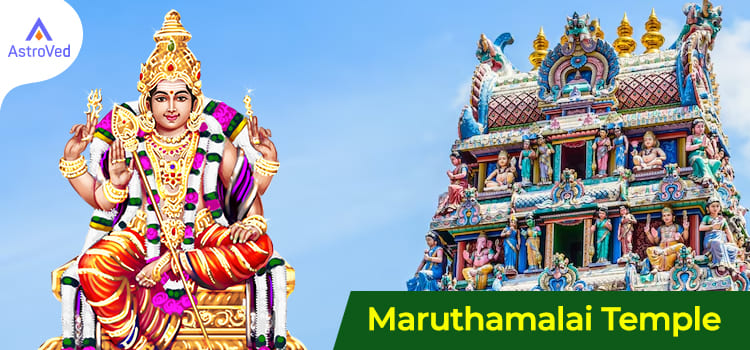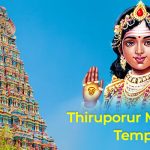Maruthamalai Temple refers to the popular abode of Muruga, Subramaniya Swamy, or Marudhachal Murthy, the 12th-century hill Temple on the outskirts of Coimbatore city. This picturesque place of worship is located on top of the Maruthamalai or Marudhamalai hillock. According to Tamil tradition, Muruga remains the God of the eco-region of Kurinj, which denotes the mountainous belt. So it is no surprise that many Muruga Temples are found upon hills; this Maruthamalai Temple is one of them.
Maruthamalai Hill
Maruthamalai Temple is located on a 600-foot granite hill. A tree known as Marudham or Marudha Maram in Tamil (also called the Arjuna tree) is native to this hill, and so the hill itself got the name Marudha Malai or Marutha Malai, the hill of the Marudha trees. Maruthamalai Temple lies on the east face of the hill, which is considered special. Maruthamalai is also part of the Western Ghats and lies about 12 km west of the central point of Coimbatore city.
Maruthamalai Temple Legend
Legends associate this Temple closely with saint Pambatti Siddhar. He mastered the knack of catching poisonous snakes even when he was young. Then, he used to remove poison from them and prepare medicines to cure snake bites. Soon, he became famous as the ‘snake doctor.’ One day, he came to these hills looking for a snake with a precious gem in it.
But there, he met a sage who transformed him completely. He advised the ‘snake doctor’ to stop looking for snakes outside but become aware of the snake that remained part of him and gain control over it through Yoga. This brought a new realization in him, and he began meditating on Muruga, who gave him his Divine Darshan. This led to his spiritual advancement and transformation as Pambatti Siddhar, meaning the snake-charmer saint.
As per belief it was Pambatti Siddhar who made the idol of Muruga of this Maruthamalai Temple.
Maruthamalai Temple Significance
Though history considers the present Temple structure to belong to the 12th century CE, the ancient Tamil literature Purananuru indicates that this Temple was built during the much earlier Sangam period, which extended roughly between the 3rd century BCE and the 3rd century CE. While the 6 Muruga Temples are very famous as Arupadai Veedu, Muruga’s 6 Battle Stations, devotees revere this Maruthamalai Temple as the 7th.
Pambatti Siddhar is one among the famous 18 Siddhars, the spiritually endowed saintly personalities. He lived in the 12th century CE. According to a version, when he was performing penance on the Maruthamalai hill, Lord Muruga appeared before him as a snake. Later, Muruga is said to have appeared before this Siddhar again with his consorts Valli and Deivanai and blessed him with the efficacious Marudha Theertham. According to folklore, a tunnel existed between the Muruga’s sanctum and the Siddhar’s cave, through which the saint used to go for Muruga worship.
At present, a pathway, which is like a staircase, leads one from the southern end of the Maruthamalai Temple complex to the Pambatti Siddhar cave, which also lies on the slopes of the hill.
The priests decorate the principal deity with gold and silver ornaments generally during day time and on special occasions, while Muruga appears in his simple form as a dhoti-wearing, staff-holding Dhandapani during the Ardhajama Pooja at night. There is a serpent deity in the Panmatti Siddhar cave, which people believe to be Muruga himself as he appeared before Pambatti Siddhar.
Maruthamalai Temple- Some Particulars and Festivals
The Maruthamalai Hill Temple lies on a hillock, which one can reach on foot by climbing the steps, which are about 837 in number, or driving up the hill by road.
At the foothills lies Than Thondri Vinayakar Temple, the abode of Ganesha, whom devotees believe is self-manifested.
Many medicinal herbs are grown on the hill, which people consider effective in curing several illnesses; hence, they are extensively used in preparing Ayurvedic medicines.
People believe praying to the deity here and performing rituals like tying the Mangalya thread and small cradles to the tree can clear marital obstacles and bestow progeny blessing. It is also a belief that consuming the holy ash given as Prasad in the Temple by mixing it in water can cure the bites of poisonous creatures, including snakes; applying this mixture can also cure skin diseases. People also worship at Pambatti Siddhar Temple, lighting a ghee lamp and offering white flowers and sweets for relief from Naga Dosha and peace of mind.
There is a steady flow of devotees to this beautiful, well-maintained hill Temple who come to seek Muruga’s grace. People celebrate all occasions significant for Muruga, including Vaikasi Visakam, his birthday, Kandha Shasti, Aadi Krithigai, and Thai Poosam, as grand festivals here.
We can also find devotees taking out the chariot procession of Muruga around the Maruthamalai Temple on many evenings on the hill itself.


